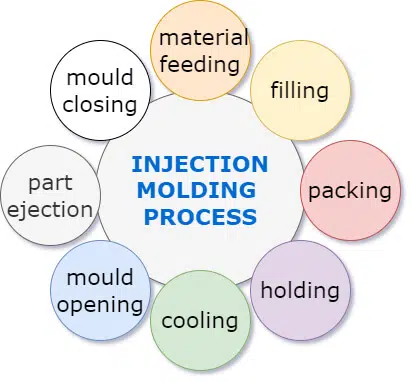■
For producing large quantities of consistent medical parts, injection molding is a common method for producing them in large quantities. Detailed knowledge of all the variables that are involved in injection molding and how they affect the successful processing of the product is of special importance to manufacturers of medical devices since they require tight tolerances and unique performance specifications. An injection-molded medical part's quality is affected by the design of the injection molding equipment, the material performance, the process variables, as well as the specific characteristics of the part.

Having said that, the injection molding cycle can roughly be divided into four phases: filling, packing, holding, and cooling/plasticization. When the resin pellets are mixed and melted, the injection molding process begins. During this process, the molten polymer is forced (injected) into a steel mold and moves through the barrel of the machine. During the process of filling and packing the mold with plastic, the part starts to take shape and begin to cool. As soon as the molded part is ejected from the mold, assembly and finishing can take place.
The equipment. You can find several types of injection molding machines that can blend, melt, and inject polymers into a mold in different ways. You can also find injection molding machines that can use various kinds of dies. There are various sizes and designs of these machines, each offering a different clamping force, the capacity of the machine, and screw design according to the needs of a specific application.
Materials. Engineers may choose from a wide variety of engineering plastics for use in devices depending on their end-use requirements. The handling and processing procedures recommended by the resin manufacturer are usually the best way to achieve the best results for each material family and resin formulation.
Processing Parameters. Injection molding outcomes are affected by several factors, including machine choice, material properties, and part design, but five additional variables can significantly affect the results. The variables are injection velocity, plastic temperature, plastic pressure, and cooling temperature and time. When these variables are controlled during each of the four phases of the injection molding process, part quality, variation reduction, and overall productivity can be improved.
- Phase 1
Plastic flows into the mold as the screw advances. Melt temperature, pressure, and shear rate all impact flow characteristics. When filling, the injection velocity, or the rotational speed of the ram (screw), is the most critical variable. The greater the injection velocity, the easier the polymer will flow. A high injection velocity, however, can cause excessive shear, resulting in splay and jetting. More importantly, hotter shear rates degrade plastics, affecting the properties of the molded parts.
Viscosity, or the resistance to flow, affects the way plastics flow during filling. In contrast, polymers with low viscosities are thinner and flow more easily. For the best results, the melt temperature should be maintained within the temperature range recommended by the manufacturer.
Plastic pressure, another variable, increases sharply during fill. The molten plastic can, in fact, be under much greater pressure than is indicated by hydraulic pressure. It is important to understand the flow characteristics during the fill of the material being used and to operate the process consistently.
- Phase 2
Plastic melt is 'packaged' by compressing it and adding more material to compensate for any shrinkage that occurs during cooling. 95% of the resin is added during filling, and 5% during packaging.
During the packing phase, plastic pressure is the most important factor. In the melt, the screw maintains pressure to compensate for shrinkage, which can lead to sinks and voids. Defects in plastic parts are typically caused by variations in cavity pressure.
As packing pressure determines the weight and dimensions of parts, it is crucial to completely fill the mold-avoiding overfilling or underfilling. An overpacked part may suffer from dimensional problems and be difficult to eject, while an under-packed part may suffer from short shots, sinks, weight variations, and warpage.
- Phase 3
Each of the five variables discussed earlier has an effect on hold: injection velocity, plastic temperature, plastic pressure, and cooling temperature and time. Molds are packaged with plastic and held in place until the plastic is partially solidified and the gate freezes. As a result of the cooling, plastic pressure drops. The hold time until the weight of the part changes can be reduced to optimize this phase. The gate then no longer seals off the mold, and resin can backflow out. Cycle time increases when the gate seals, causing more energy and time to be used to produce the part. Ensure that the plastic is kept under pressure until it freezes.
- Phase 4
It is typically the cooling and plasticizing process that takes most of the cycle time - up to 80%. Optimizing cooling time can result in significant productivity improvements. During this phase, the only variables are the cooling temperature and the time. It is important to balance the desire to cool quickly against the amount of mold-in stress that the final part can handle during the cooling phase.
Considerations for designing. Parts should be designed for functionality as well as increased strength and ease of manufacturing. A lack of understanding of the basic principles of good design can result in significant problems in both processing and performance. By following basic design guidelines for nominal walls, corner radiuses, holes, projections, drafts, and gates, parts are more likely to process and perform satisfactorily.
Design elements can compensate for changes in material properties caused by end-use factors (e.g., sterilization). With knowledge of the chosen material and end-use requirements, design factors that increase localized stress should be examined.
During the product development cycle, it is good to focus on fundamentals by reviewing a simple list of design basics. Design contributes to part performance, processing ease, and overall productivity even if it does not guarantee molding success.